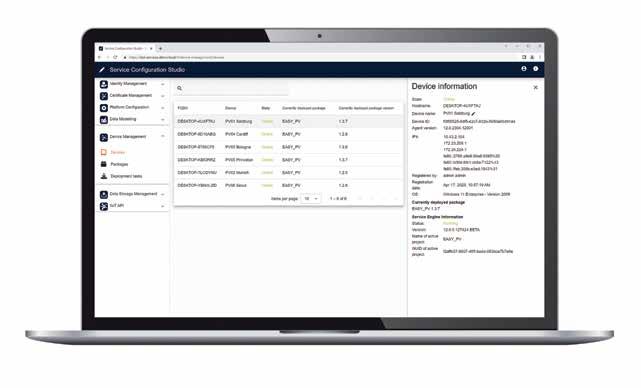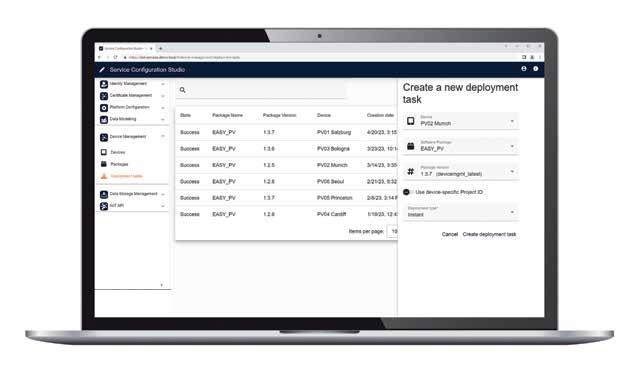
4 minute read
LET ME HANDLE THAT FOR YOU!
Digital networks offer many companies the potential to provide new services, such as remote diagnosis and remote maintenance. Find out how you can get fit for the future using the zenon software platform and our new Device Management service.
Digital transformation is in full swing. Production data is increasingly being used by businesses to make informed decisions. Data-driven decision-making promises more efficient production processes, less downtime, and reduced energy consumption.
For this reason, connected machines and equipment that send data to central instances, whether continuously or in blocks, are critical. On the one hand, connectivity requires higher security requirements for the technical systems involved. On the other hand, it allows machines to be used at remote locations and, under certain circumstances, these machines can run even without operating personnel. Examples of this are the monitoring of energy converters in distributed photovoltaic systems or equipment used worldwide in the food and beverage industry.
In any case, it will be necessary to monitor equipment operation and status via data interfaces in order to take action when needed. This can range, for example, from simple configuration and troubleshooting to importing configuration changes and security updates.
Things are also easier for service personnel if they can check on the state of equipment and keep track of logs remotely.
Remote maintenance improves sustainability and energy efficiency since it eliminates unnecessary travel. This saves time and money and reduces emissions. Predictive maintenance functions also make it easier to optimize equipment and processes, enabling service personnel to intervene and prevent equipment or machine downtime.
For this reason, we are working on new features in zenon intended to support these activities and optimization strategies. Our new zenon Device Management service is at the heart of these developments. It can be used flexibly, as with other zenon IIoT Services. We will continue to develop this service over the next few years, guided by a targeted but flexible vision.
The Vision Behind Zenon Device Management
Device Management focuses primarily on managing services for the zenon software platform. For example, our plans include manual and automatic updates of zenon projects on connected machines or the initial installation of zenon components.
A tagging system, combined with a configurable set of rules, is intended to provide further flexibility for rolling out fully or semi-automated updates. For example, the solution will support workflows that allow project changes to be uploaded and then enable the equipment operator to install the upload at a later time. This could be performed after manual confirmation during a maintenance window or a period of downtime. These types of processes will be particularly useful for batch updates, where the same update can be uploaded to multiple identical machines. The system takes into account equipment-specific settings and parameters when installing these updates, in order to retain the individual properties for each instance.


When it comes to error handling and support activities, functions such as retrieving log messages and viewing system parameters such as CPU, memory, or network utilization are designed to make life easier for service personnel.
Where We Stand Today
Following our vision for zenon Device Management, we have divided the implementation of the functionality into successive phases. The priority is on the greatest possible benefit for applications.
Currently, device agents can be installed and registered on Windows and selected Linux operating systems. A device agent is installed on every connected machine and receives the tasks to be carried out from the central Device Management service.
To distribute projects, the fully compiled zenon project can be uploaded directly from zenon Engineering Studio to the Device Management service using a wizard. The upload is completed after the relevant user authentication and authorization checks are performed.
Once the package with the project content is available in zenon Device Management, it can be transferred to a connected machine and installed by creating a deployment task. In this step, you can choose to run the installation immediately or at a future time. The feedback and any log information from the installation process is then shared with zenon Device Management so that the administrator is notified regarding the success of the installation. As an option, users can also activate the automatic connection to the IIoT Services and, consequently, data storage or the IIoT API. The device agent takes care of the necessary settings and thus reduces the related configuration steps.
A corresponding view with filter options is available to keep track of the project versions uploaded already. The different projects can also be viewed and managed here.
In addition to distributing zenon projects, remote-controlled updates of the Device Agent component are also supported. This ensures that the Device Agent contains the latest functions and security measures at all times.
For the equipment overview, basic information –such as the computer name, assigned IP addresses, operating system version, and the version of the installed zenon Service Engine – is identified and displayed centrally in zenon Device Management.
The Next Steps
Future versions of zenon Device Management will include new and expanded functionalities that, for example, collect log messages from the installed zenon services. Running batch-based updates simultaneously on multiple machines is also an important aspect of this functionality. In particular, it will enable users to more efficiently manage all of the connected zenon Service Engine instances and zenon projects.
As you can see, we have big plans for Device Management on the zenon software platform as we steadily expand its range of functions.
You can look forward to more forthcoming features and the exciting possibilities they will enable!
MATTHIAS SCHNÖLL Product Manager
Matthias Schnöll joined COPA-DATA in 2015. He has been part of the Product Management team since 2018. As a product owner, he works on developing the zenon software platform. His main focus is on zenon IIoT Services and all cloud-related issues. He considers bridging the gap between OT and IT as one of today’s most important challenges.
matthias.schnoell@copadata.com











